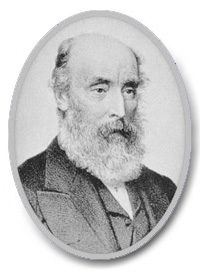Robert Richard Torrens
Robert Torrens (1814–1884) is best known for the
the Land Title first introduced in South Australia in 1858
and since spread to many countries. The land Title system
is a process whereby the ownership of land is determined
by a single deed called a title rather than a collection
of documents.
Originally a Land Grant was the only document of ownership,
and remained in possession of the owner of the land. Details
of successive owners were not recorded. Title to land was
transferred by deed, which was handed over to the new owner,
together with the title. Since the title itself was not
noted, every deed formed part of the chain of documentation
proving ownership back to the original Land Grant. If any
of these deeds became lost, ownership could no longer be
established with any certainty.
In 1857 Torrens introduced his Bill to the South Australian
Parliament which was to become the Real Property Act. The
system embodied in the Act has been picked up in other jurisdictions
within and beyond Australia. The Torrens System creates
interests in land by the official act of registration of
the instrument in the Register, and the interest of the
owner is guaranteed by the Crown subject to certain limited
exceptions. This system of land registration provided for
each certificate as a title to be in duplicate, with the
original being part of the Register and open to search by
the public. The single register for each land holding records
all details and interests affecting that land such as easements,
covenants, mortgages, resumptions, caveats, and subsequent
changes in ownership.
Torrens also briefly served as a Premier for South Australia
before returning to England in 1863 where he subsequently
gained a knighthood in 1872 for serving as a parliamentarian.
His works in SA are often the subject of strong debate but
while he may not have been the architect of the title system
(Dr Ulrich Hübbe, a German settler who had gained a
doctorate in law at the University of Kiel based the new
system on the one in operation in Hanseatic cities), he
certainly steered it through the SA parliament and worked
hard to encourage other Australian colonies to adopt the
system which was far superior to the previous arrangements
and was good enough to remain accepted practice to the present
day.
Torrens led a rather colourful life in the colony of SA
and at times clearly behaved illegally but also managed
to survive any purge! He was initially appointed collector
of customs in 1841 and used that office to his own benefit!
He pursued an extravagant lifestyle from his home, St
Clair, which he had built on 70 acres of land at Woodville
and despite his relatively humble post, by the end of 1850
his bank balance was £18,000. Soon afterwards he built
Torrens Park on 134 acres at Mitcham. This property
was considered to be the grandest and most imposing mansion
ever erected in South Australia. While some suggest he had
been defrauding the revenue, others claim that it was his
use of inside knowledge to speculate successfully in land.
While Robert Torrens may have served the colony of South
Australia, he did not give his name to the river that flows
through Adelaide. That distinction belongs to his father,
Robert Torrens snr (1780–1864), a member of the British
Parliament at the time of settlement and the Chairman of
the South Australian Colonisation Commission.
|